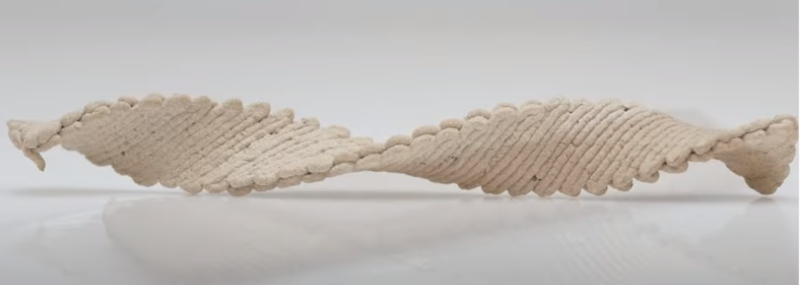
Wood-based AM process creates flat parts that morph into 3D shapes
By DE Staff
Additive ManufacturingHebrew University of Jerusalem researchers say technique could create flat-packs that morph into final products after delivery.

(Photo credit: Hebrew University of Jerusalem)
Researchers at the Hebrew University of Jerusalem announced the development of an AM process that creates flat wood-based objects which morph into complex 3D shapes when they dry.
Similar 3D printing techniques that “program” parts to morph after printing have been made from plastics and other synthetic materials and relied on a change in temperature pH or moisture content. In contrast, the Hebrew University of Jerusalem team’s process uses a water-based ink composed of wood-waste microparticles known as “wood flour” mixed with cellulose nanocrystals and xyloglucan.
Using this build material, created at the university, the team discovered that by changing the way the ink is laid down also changed a part’s morphing behavior as it dried. For instance, a flat disk printed as a series of concentric circles dries and shrinks to form a saddle-like structure, while a disk printed as a series of rays emanating from a central point turns into a dome or cone-like structure.
In addition, the team found that adjusting print speed affected the printed objects morphed shape, since shrinkage occurs perpendicular to the wood fibers in the ink, and print speed changes the degree of alignment of those fibers. A slower rate leaves the particles more randomly oriented, so shrinkage occurs in all directions. Faster printing aligns the fibers with one another, so shrinkage is more directional.
The scientists learned how to program the print speed and pathway to achieve a variety of final shapes. For example, stacking two rectangular layers printed in different orientations yields a helix after drying. In their latest work, they discovered how to manipulate pathway, speed and stacking to control whether the helix spirals clockwise or counterclockwise.
According to the researchers, further refinement will allow the team to combine the saddles, domes, helices and other basic shapes to produce complicated final objects, such as a chair. Ultimately, it could be possible to make wood products that are shipped flat to the end user, which could reduce shipping volume and costs. The team is also exploring whether the morphing process could be made reversible.
https://en.huji.ac.il/en
